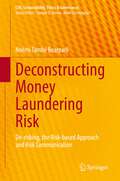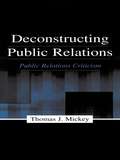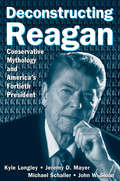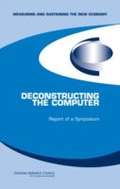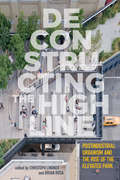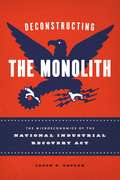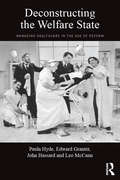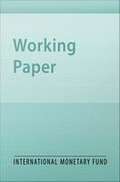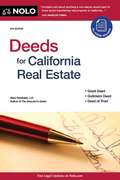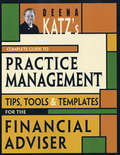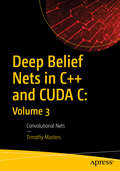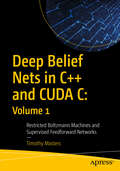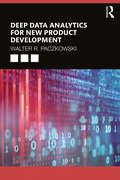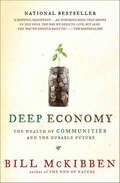- Table View
- List View
Deconstructing Money Laundering Risk: De-risking, the Risk-based Approach and Risk Communication (CSR, Sustainability, Ethics & Governance)
by Noémi També BearparkThis book examines the interpretation of the risk-based approach (RBA) and its application across the banking industry. It explores the ways conflicting risk interpretation and deconstruction of money laundering risk have unintended consequences across the banking industry. Furthermore, it offers a theoretical framework that can be adopted and implemented by risk practitioners to address money laundering (ML) risks. The interpretation and application of the RBA influences the way money laundering risk is perceived, presented, and managed, often resulting in misalignment among stakeholders. Moreover, AML practitioners interpret money laundering (ML) risk as an entity that can be contained, largely in ignorance of the fact that ML risk is self-referential. The book therefore addresses complex inter-system feedback phenomena that lead to de-risking and re-risking, and offers a new ML risk communication framework on this basis. It will be of value to researchers and also to stakeholders within financial institutions, financial intelligence units and regulators in the fight against money laundering.
Deconstructing Public Relations: Public Relations Criticism (Routledge Communication Series)
by Thomas J. MickeyThis volume provides a critical look at public relations practice, utilizing case studies from public relations, advertising, and marketing to illustrate the deconstruction and analysis of public relations campaigns. Author Thomas J. Mickey uses a cultural studies approach and demonstrates how it can be used as a critical theory for public relations practice, offering real-world examples to support his argument. Through the interpretive act of deconstruction, this book serves to challenge the myth of public relations as an objective "science," allowing the social importance of public relations to be redefined and encouraging public relations to take a fuller place in the interdisciplinary study of text and knowledge. Intended for public relations scholars and students in public relations cases/campaigns, public relations criticism, and media studies courses, Deconstructing Public Relations: Public Relations Criticism demystifies the act of deconstruction and shows how it can give insight into the theory and practice of public relations.
Deconstructing Reagan: Conservative Mythology and America's Fortieth President
by Michael Schaller Kyle Longley Jeremy Mayer John W. SloanAlthough he left office nearly 20 years ago, Ronald Reagan remains a potent symbol for the conservative movement. The Bush administration frequently invokes his legacy as it formulates and promotes its fiscal, domestic, and foreign policies. His name is watchword for campus conservatives who regard him in a way that borders on hero worship. Conservative media pundits often equate the term "Reagan-esque" with personal honor, fiscal rectitude, and unqualified success in dealing with foreign threats. But how much of the Reagan legacy is based on fact, how much on idealized myth? And what are the reasons - political and otherwise - behind the mythmaking? "Deconstructing Reagan" is a fascinating study of the interplay of politics and memory concerning our fortieth president. While giving credit where credit is due, the authors scrutinize key aspects of the Reagan legacy and the conservative mythology that surrounds it.
Deconstructing the Computer: Report of a Symposium
by National Research Council of the National AcademiesStarting in the mid 1990s, the United States economy experienced an unprecedented upsurge in economic productivity. Rapid technological change in communications, computing, and information management continue to promise further gains in productivity, a phenomenon often referred to as the New Economy. To better understand this phenomenon, the National Academies Board on Science, Technology, and Economic Policy (STEP) has convened a series of workshops and commissioned papers on Measuring and Sustaining the New Economy. This major workshop, entitled Deconstructing the Computer, brought together leading industrialists and academic researchers to explore the contribution of the different components of computers to improved price-performance and quality of information systems. The objective was to help understand the sources of the remarkable growth of American productivity in the 1990s, the relative contributions of computers and their underlying components, and the evolution and future contributions of the technologies supporting this positive economic performance.
Deconstructing the High Line: Postindustrial Urbanism and the Rise of the Elevated Park
by Alan Smart Brian Rosa Christoph Lindner Daan Wesselman Danya Sherman Darren Patrick James Corner Julian Brash Kevin Loughran Nate Millington Phil Birge-Liberman Scott Larson Tom BakerThe High Line, an innovative promenade created on a disused elevated railway in Manhattan, is one of the world’s most iconic new urban landmarks. Since the opening of its first section in 2009, this unique greenway has exceeded all expectations in terms of attracting visitors, investment, and property development to Manhattan’s West Side. Frequently celebrated as a monument to community-led activism, adaptive re-use of urban infrastructure, and innovative ecological design, the High Line is being used as a model for numerous urban redevelopment plans proliferating worldwide.Deconstructing the High Line is the first book to analyze the High Line from multiple perspectives, critically assessing its aesthetic, economic, ecological, symbolic, and social impacts. Including several essays by planners and architects directly involved in the High Line’s design, this volume also brings together a diverse range of scholars from the fields of urban studies, geography, anthropology, sociology, and cultural studies. Together, they offer insights into the project’s remarkable success, while also giving serious consideration to the critical charge that the High Line is “Disney World on the Hudson,” a project that has merely greened, sanitized, and gentrified an urban neighborhood while displacing longstanding residents and businesses.Deconstructing the High Line is not just for New Yorkers, but for anyone interested in larger issues of public space, neoliberal redevelopment, creative design practice, and urban renewal.
Deconstructing the Monolith: The Microeconomics of the National Industrial Recovery Act (Markets and Governments in Economic History)
by Jason E. TaylorThe National Industrial Recovery Act (NIRA) was enacted by Congress in June of 1933 to assist the nation’s recovery during the Great Depression. Its passage ushered in a unique experiment in US economic history: under the NIRA, the federal government explicitly supported, and in some cases enforced, alliances within industries. Antitrust laws were suspended, and companies were required to agree upon industry-level “codes of fair competition” that regulated wages and hours and could implement anti-competitive provisions such as those fixing prices, establishing production quotas, and imposing restrictions on new productive capacity. The NIRA is generally viewed as a monolithic program, its dramatic and sweeping effects best measurable through a macroeconomic lens. In this pioneering book, however, Jason E. Taylor examines the act instead using microeconomic tools, probing the uneven implementation of the act’s codes and the radical heterogeneity of its impact across industries and time. Deconstructing the Monolith employs a mixture of archival and empirical research to enrich our understanding of how the program affected the behavior and well-being of workers and firms during the two years NIRA existed as well as in the period immediately following its demise.
Deconstructing the Welfare State: Managing Healthcare in the Age of Reform
by John Hassard Paula Hyde Leo McCann Edward GranterWho are NHS middle managers? What do they do, and why and how do they do it’? This book explores the daily realities of working life for middle managers in the UK’s National Health Service during a time of radical change and disruption to the entire edifice of publicly-funded healthcare. It is an empirical critique of the movement towards a healthcare model based around HMO-type providers such as Kaiser Permanente and United Health. Although this model is well-known internationally, many believe it to be financially and ethically questionable, and often far from 'best practice' when it comes to patient care. Drawing on immersive ethnographic research based on four case studies – an Acute Hospital Trust, an Ambulance Trust, a Mental Health Trust, and a Primary Care Trust – this book provides an in-depth critical appraisal of the everyday experiences of a range of managers working in the NHS. It describes exactly what NHS managers do and explains how their roles are changing and the types of challenges they face. The analysis explains how many NHS junior and middle managers are themselves clinicians to some extent, with hybrid roles as simultaneously nurse and manager, midwife and manager, or paramedic and manager. While commonly working in ‘back office’ functions, NHS middle managers are also just as likely to be working very close to or actually on the front lines of patient care. Despite the problems they regularly face from organizational restructuring, cost control and demands for accountability, the authors demonstrate that NHS managers – in their various guises – play critical, yet undervalued, institutional roles. Depicting the darker sides of organizational change, this text is a sociological exploration of the daily struggle for work dignity of a complex, widely denigrated, and largely misunderstood group of public servants trying to do their best under extremely trying circumstances. It is essential reading for academics, students, and practitioners interested in health management and policy, organisational change, public sector management, and the NHS more broadly.
Deconstructing ‘Energy Security’ in Oman: A Journey of Securitisation from 1920 to 2020 (Gulf Studies #6)
by Lamya HarubThis book makes a substantial and timely contribution to discussions on energy security in Oman, providing a systematic analysis of energy security in Oman from 1920 to 2020. It is particularly relevant in light of the recent global geopolitics of the Gulf particularly, and the Middle Eastern region broadly, as well as connecting to current climate change research and debates. Combining a political sociological account with postcolonial concepts within a theoretical and empirical exploration of energy politics, the book weaves a study of energy security into the historical and contemporary development of political, economic, security, and social structures in Oman. Including interviews with Omani and Oman-based practitioners, as well as grounded in historical documents which include Arabic-language sources, this book evaluates the energy question beyond the typical economic perspective, considering socio-political opportunities and challenges. It also makes economic-related recommendations in tandem with rentier state theory. Unlike the dominant accounts of energy security in Oman, this book sets itself apart by moving away from utilising liberal and realist approaches for its analysis and engages systematically with critical security studies to introduce a non-Eurocentric perspective to the arena. Of interest to scholars in Middle Eastern history, energy security, and security studies, this book assumes an important place in the critical literature on the Gulf, particularly within environmental studies and energy policy literature.
Decoupling from the East Toward the West? Analyses of Spillovers to the Baltic Countries
by Kingsley I. ObioraA report from the International Monetary Fund.
Dedollarization
by Annamaria Kokenyne Romain Veyrune Jeremy LeyA report from the International Monetary Fund.
Dedollarization in Liberia--Lessons from Cross-country Experience
by Lodewyk Erasmus Jules Leichter Jeta MenkulasiA report from the International Monetary Fund.
Deduct Everything!: Save Money with Hundreds of Legal Tax Breaks, Credits, Write-Offs, and Loopholes
by Eva RosenbergFrom nationally-recognized tax expert, bestselling author, and columnist at MarketWatch, DEDUCT EVERYTHING! is full of strategies and tips, organized by topic, designed to reduce taxes in everyday life. Rosenberg also provides references and links to websites, etc, where taxpayers can go to get the latest forms. Rosenberg will walk taxpayers through the documentations required and help make sure the deductions are audit-proof. Designed to be a comprehensive guide to legal deductions and loopholes available to individual tax filers, the tax-reducing strategies cover: family, home, and car job or businesses, including Airbnb, Uber, and more investments and retirement savings medical and dental expenses and health savings accounts education costs and charitable givingThe advice will be rounded out with real-life stories from Rosenberg's clients across the country detailing exactly how to make sure the deductions are being applied correctly. A special bonus chapter will detail the tax "no-no's" Rosenberg has seem so that readers can make sure they know what mistakes to avoid.
Deduct It!
by Stephen FishmanBusiness tax deductions, from start-up to success -- learn how to Deduct It! Completely updated for 2012 returns! Understanding tax deductions is one of the keys to start-up success. Learn how to make more money for your small business by paying the IRS less -- let Deduct It! show you how to quickly maximize the business deductions you're legally entitled to. Learn how to make year-round business decisions that will pay off come tax time and avoid IRS problems with this comprehensive book. All the information you need is organized into practical categories featuring common deductions for small business owners, including: - start-up expenses - operating expenses - health deductions - vehicles - travel - entertainment - meals - inventory - equipment - and many more This edition is completely updated with all the latest tax information, eligibility requirements, and tax rates for 2012 returns, including substantive updates to the law. Whether your business is just starting or well-established, Deduct It! is indispensable to your venture.
Deduct It! Lower Your Small Business Taxes (5th edition)
by Stephen FishmanFishman, an attorney who has written other legal self-help books, shows small business entrepreneurs how to maximize business deductions. He provides basic background on how different business structures are taxed and how tax deductions work, and gives advice on keeping audit-proof records, avoiding common mistakes, and choosing the right tax-saving strategies for businesses year-round. Information on deductions is organized into categories according to the most common deductions. Coverage encompasses the latest tax laws through the beginning of 2004. Annotation ©2004 Book News, Inc., Portland, OR (booknews.com)
Deduct It!: Lower Your Small Business Taxes
by Stephen Fishman J. D.<p>Deduct It! shows you how to maximize your business deductions quickly, easily and legally. Easy to read and full of real-world examples, Deduct It! will pay for itself many times over. It covers deductions for: <BR>start-up and operating expenses <BR>travel, meals, and entertainment <BR>home offices <BR>medical expenses under Obamacare <BR>equipment and inventory <BR>and more. <p>Deduct It! shows you how to avoid problems with the IRS, such as having your business classified as a hobby. Whether your enterprise is just starting or well established, this book is indispensable to your financial success. <p>If the tax laws change, we will post updates on a special page on Nolo.com. That way, you’ll always have access to up-to-date information if there are significant changes to the law. <p>All the information in the book remains up-to-date for the 2017 tax year. The changes brought about by the Tax Cuts and Jobs Act all take effect in 2018, except for an increase in bonus depreciation which took effect September 27, 2017. Anyone who purchases the book has access to an update page on the Nolo website specific to this book which explains the 2017 bonus depreciation change and summarizes how the new tax law affects small business owners’ taxes for 2018 and later. A new edition of the book, completely updated for the new tax law, will be published August 1, 2018.
Deduct It!: Lower Your Small Business Taxes
by Stephen FishmanReduce your taxes Completely updated for 2016 returns! Deduct It! shows you how to maximize your business deductions quickly, easily and legally. Easy to read and full of real-world examples, Deduct It! will pay for itself many times over. It covers deductions for: start-up and operating expenses travel, meals, and entertainment home offices medical expenses under Obamacare equipment and inventory and more. Deduct It! shows you how to avoid problems with the IRS, including having your business classified as a hobby. Whether your enterprise is just starting or well established, this book is indispensable to your financial success. Includes the top business deductions--the most valuable ones and how to claim them.
Deduct It!: Lower Your Small Business Taxes
by Stephen FishmanReduce your taxes Completely updated for 2017 returns! Deduct It! shows you how to maximize your business deductions quickly, easily and legally. Easy to read and full of real-world examples, Deduct It! will pay for itself many times over. It covers deductions for: start-up and operating expenses travel, meals, and entertainment home offices medical expenses under Obamacare equipment and inventory and more. Deduct It! shows you how to avoid problems with the IRS, such as having your business classified as a hobby. Whether your enterprise is just starting or well established, this book is indispensable to your financial success. Includes the top and most valuable business deductions and how to claim them.
Deduct It!: Lower Your Small Business Taxes
by Stephen FishmanReduce your taxes Deduct It! shows you how to maximize your business deductions—quickly, easily, and legally. Whether your business is just starting or well established, this book is indispensable to your financial success. It covers deductions for: start-up and operating expenses travel and meals home offices medical expenses equipment and inventory and more. Learn about the new tax law and how it affects small business owners, including the new 20% pass-through deduction and changes to entertainment and other business deductions and credits. Easy to read and full of real-world examples, Deduct It! will pay for itself many times over. This edition is completely updated to cover the new Tax Cuts and Jobs Act.
Deeds for California Real Estate
by Mary Randolph J.D.Transfer California property to someone else with the easy-to-use legal forms and information in this guide Whenever you transfer real estate in the Golden State -- because of marriage, divorce, death or for estate planning purposes -- you need a new deed. Deeds for California Real Estate shows you how to choose the right kind of deed, create it, then file it with the county recorder. This plain-English book has all the forms youíll need, with step-by-step instructions for completing them quickly and accurately. Learn how to: put real estate in joint tenancy or community property add or remove someone's name from the title of real estate you own transfer real estate into, or out of, a revocable living trust transfer property into a family corporation or partnership borrow or lend money with real estate as security use real estate as security for a loan buy out a co-owner of jointly held real estate Deeds for California Real Estate explains potential complications involving gift taxes, spouses' property rights, disclosure statements required by state or federal law, and tax and estate planning aspects of property transfers. The 8th edition is completely updated with the latest federal gift and estate tax information. The CD-ROM that accompanies the printed version of this book includes forms or other tools; in this eBook, you'll find all those documents in the appendix or at the back of the book.
Deeds for California Real Estate (6th edition)
by Mary RandolphWhenever property is transferred in California, a new deed is required. Aimed at non-lawyers, this accessible guide explains how to choose the right kind of deed, draw it up, and file it with the county recorder. All of the necessary forms are provided in a photocopiable format and are accompanied by step-by-step instructions.
Deena Katz's Complete Guide to Practice Management: Tips, Tools, and Templates for the Financial Adviser (Bloomberg Financial #64)
by Deena B. KatzDeena B. Katz, CFP, a preeminent authority on practice management and an internationally recognized financial adviser, presents a comprehensive guide to running a professional financial planning practice. To create this book, Katz updated, revised, and combined her two acclaimed books Deena Katz on Practice Management (1999) and Deena Katz's Tools and Templates for Your Practice (2001). In this newly expanded volume, she presents the essentials on how to help a practice thrive side by side with the tools and templates needed for the everyday operation of your firm. This new volume offers guidance on practice-management issues: setting up an office systems and technology administration and staffing marketing growing as the market changes hanging on to clients for the long term succession planning when the time comes This comprehensive resource provides sample forms, worksheets, templates, letters, brochures, and collateral materials developed and refined by top wealth managers and planners. From keeping the business running well by designing dynamic collateral material, to considering plans for retirement, Deena B. Katz guides advisers through every challenge a financial planning business will face.
Deep Belief Nets in C++ and CUDA C: Convolutional Nets
by Timothy MastersDiscover the essential building blocks of a common and powerful form of deep belief network: convolutional nets. This book shows you how the structure of these elegant models is much closer to that of human brains than traditional neural networks; they have a ‘thought process’ that is capable of learning abstract concepts built from simpler primitives. These models are especially useful for image processing applications. At each step Deep Belief Nets in C++ and CUDA C: Volume 3 presents intuitive motivation, a summary of the most important equations relevant to the topic, and concludes with highly commented code for threaded computation on modern CPUs as well as massive parallel processing on computers with CUDA-capable video display cards. Source code for all routines presented in the book, and the executable CONVNET program which implements these algorithms, are available for free download.What You Will LearnDiscover convolutional nets and how to use themBuild deep feedforward nets using locally connected layers, pooling layers, and softmax outputsMaster the various programming algorithms requiredCarry out multi-threaded gradient computations and memory allocations for this threadingWork with CUDA code implementations of all core computations, including layer activations and gradient calculationsMake use of the CONVNET program and manual to explore convolutional nets and case studiesWho This Book Is ForThose who have at least a basic knowledge of neural networks and some prior programming experience, although some C++ and CUDA C is recommended.
Deep Belief Nets in C++ and CUDA C: Restricted Boltzmann Machines And Supervised Feedforward Networks (Deep Belief Nets In C++ And Cuda C Ser.)
by Timothy MastersDiscover the essential building blocks of the most common forms of deep belief networks. At each step this book provides intuitive motivation, a summary of the most important equations relevant to the topic, and concludes with highly commented code for threaded computation on modern CPUs as well as massive parallel processing on computers with CUDA-capable video display cards. The first of three in a series on C++ and CUDA C deep learning and belief nets, Deep Belief Nets in C++ and CUDA C: Volume 1 shows you how the structure of these elegant models is much closer to that of human brains than traditional neural networks; they have a thought process that is capable of learning abstract concepts built from simpler primitives. As such, you’ll see that a typical deep belief net can learn to recognize complex patterns by optimizing millions of parameters, yet this model can still be resistant to overfitting. All the routines and algorithms presented in the book are available in the code download, which also contains some libraries of related routines. What You Will LearnEmploy deep learning using C++ and CUDA CWork with supervised feedforward networks Implement restricted Boltzmann machines Use generative samplingsDiscover why these are importantWho This Book Is ForThose who have at least a basic knowledge of neural networks and some prior programming experience, although some C++ and CUDA C is recommended.
Deep Data Analytics for New Product Development
by Walter R. PaczkowskiThis book presents and develops the deep data analytics for providing the information needed for successful new product development. Deep Data Analytics for New Product Development has a simple theme: information about what customers need and want must be extracted from data to effectively guide new product decisions regarding concept development, design, pricing, and marketing. The benefits of reading this book are twofold. The first is an understanding of the stages of a new product development process from ideation through launching and tracking, each supported by information about customers. The second benefit is an understanding of the deep data analytics for extracting that information from data. These analytics, drawn from the statistics, econometrics, market research, and machine learning spaces, are developed in detail and illustrated at each stage of the process with simulated data. The stages of new product development and the supporting deep data analytics at each stage are not presented in isolation of each other, but are presented as a synergistic whole. This book is recommended reading for analysts involved in new product development. Readers with an analytical bent or who want to develop analytical expertise would also greatly benefit from reading this book, as well as students in business programs.
Deep Economy: The Wealth of Communities and the Durable Future
by Bill McKibbenThe bestselling author of The End of Nature issues an impassioned call to arms for an economy that creates community and ennobles our livesIn this powerful and provocative manifesto, Bill McKibben offers the biggest challenge in a generation to the prevailing view of our economy. For the first time in human history, he observes, "more" is no longer synonymous with "better"—indeed, for many of us, they have become almost opposites. McKibben puts forward a new way to think about the things we buy, the food we eat, the energy we use, and the money that pays for it all. Our purchases, he says, need not be at odds with the things we truly value.McKibben's animating idea is that we need to move beyond "growth" as the paramount economic ideal and pursue prosperity in a more local direction, with cities, suburbs, and regions producing more of their own food, generating more of their own energy, and even creating more of their own culture and entertainment. He shows this concept blossoming around the world with striking results, from the burgeoning economies of India and China to the more mature societies of Europe and New England. For those who worry about environmental threats, he offers a route out of the worst of those problems; for those who wonder if there isn't something more to life than buying, he provides the insight to think about one's life as an individual and as a member of a larger community.McKibben offers a realistic, if challenging, scenario for a hopeful future. Deep Economy makes the compelling case that the more we nurture the essential humanity of our economy, the more we will recapture our own.
